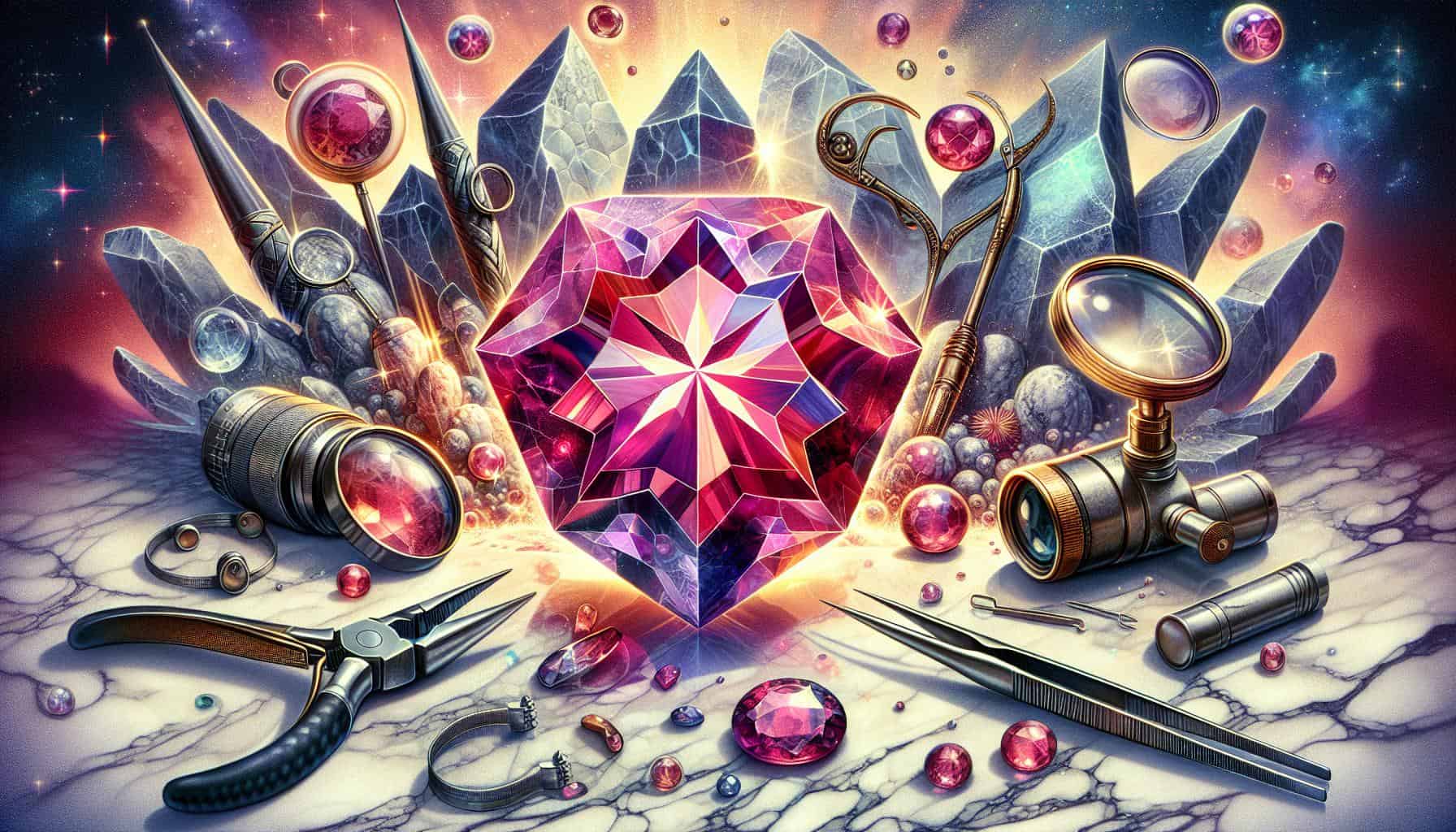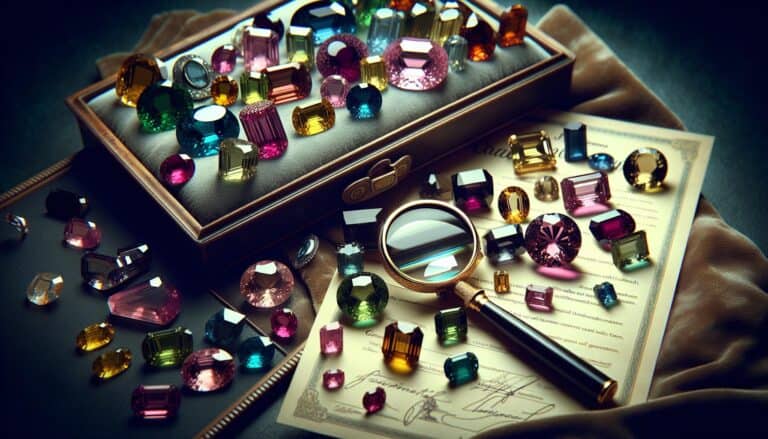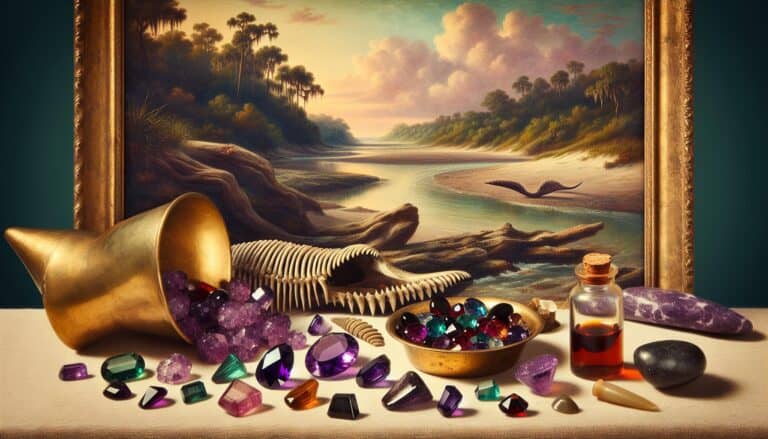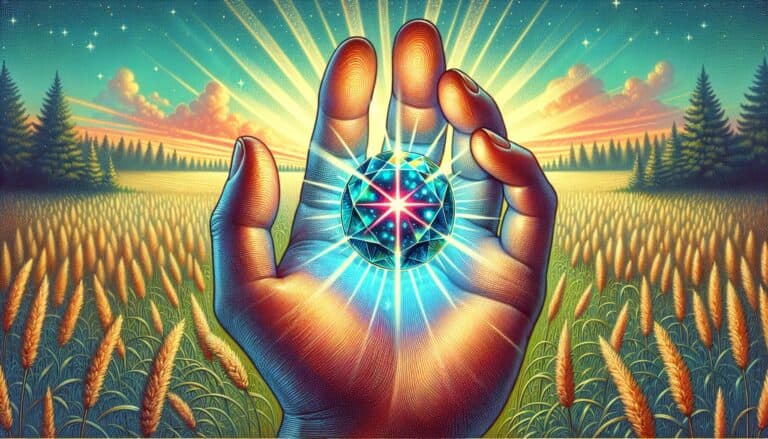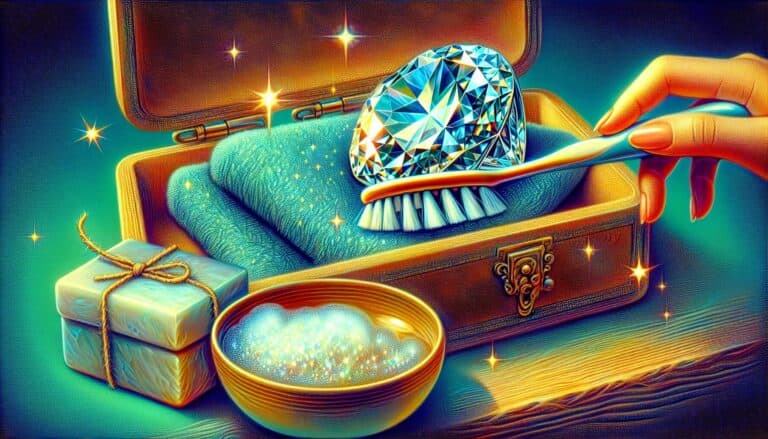Star rubies are a mesmerizing gemstone with a celestial secret hidden within their depths.
As you gaze into their crimson hues, you might catch the glint of a six-rayed star dancing across the surface. But how can you tell if you’ve got a genuine star ruby in your hands?
Distinguishing a real star ruby from imitations or treated stones requires a keen eye and a bit of know-how.
In the following paragraphs, you’ll learn the key characteristics that set authentic star rubies apart, ensuring you can identify these gems with confidence.
Dazzling asterism marks the real star ruby. Six-rayed star dances under light, not magnetic, hard as nails (9 Mohs). Check clarity, refraction, density. Careful cleaning, safe storage for lasting celestial magic.
How to Identify Star Ruby Through Testing
When you’re on the hunt for a genuine star ruby, it’s crucial to understand the testing methods that’ll let you differentiate the real deal from imitations. Discerning the authenticity of a star ruby involves more than just admiring its beauty—you’ll need to conduct a series of tests. Below, delve into the specifics of each assessment to arm yourself with the knowledge to identify a true star ruby.
Visual Inspection
Begin by examining the stone under a strong light. You’re looking for that telltale six-rayed star which should move across the stone’s surface as you rotate it. Watch how the light reflects off the stone’s surface; the star should be clear and centered. The asterism—or the star effect—should be visible under natural light without any artificial enhancement. Be wary of stones with stars that appear too perfect as they might be synthetic or treated.
The Streak Test
One simple way to test a potential star ruby is using the streak test. Rub the stone across an unglazed piece of porcelain tile. A genuine star ruby is expected to leave a colorless streak. If you observe any red color, it’s an indication that the stone may not be authentic.
Magnet Test
Although not definitive, the magnet test is a quick way to gauge authenticity. Bring a magnet close to the star ruby. Natural rubies are not magnetic; however, if there are any impurities with magnetic properties within, there may be some attraction. If the stone is strongly magnetic, it’s likely not a star ruby.
Hardness Test
Star rubies rate 9 on the Mohs scale, making them incredibly durable. Use them to scratch a piece of glass or metal—if they leave a mark, they’re likely genuine. However, don’t conduct this test forcefully as it may damage a genuine stone.
Birefringence Test
Examine your star ruby under a polariscope to look for birefringence, which is a doubling of back lines when looking through the stone. This phenomenon occurs due to the anisotropic properties of natural rubies. If birefringence is present, it’s a good indication that your star ruby is authentic.
Checking The Diaphaneity
The translucency of a star ruby can tell you a lot about its genuineness. Most natural star rubies have a certain level of diaphaneity, allowing some light to pass through but not enough to be transparent. If the stone is too transparent or completely opaque, it might be treated or synthetic.
Single or Double Refraction
Like the birefringence test, checking for single or double refraction helps in authentication. Star rubies are anisotropic and display double refraction. You can see this through a dichroscope where two images of the stone’s back can be seen due to the stone’s double refractive nature.
Refractive Index Test
Use a refractometer to measure the stone’s refractive index (RI). Natural star rubies typically have an RI value between 1.76 and 1.78. Values significantly outside this range could indicate the stone is not a genuine star ruby.
| Star Ruby Refractive Index |
|---|
| Typically 1.76 – 1.78 |
Finding The Specific Gravity
The specific gravity (SG) of a star ruby is an indicator of authenticity. A genuine star ruby usually has an SG in the range of 3.97 to 4.05. You’ll need a hydrostatic balance or a specific gravity kit for accurate measurements.
| Star Ruby Specific Gravity |
|---|
| 3.97 to 4.05 |
Identifying Star Rubies in the Field
When you’re in the field, you can sometimes spot potential star rubies based on their host rocks. Star rubies are usually found in metamorphic rocks like marble. Their crystalline structure and hexagonal shape can also be identifiers. Keep in mind that fine-quality star rubies are rare, so encountering them in the field isn’t common.
Recognizing Potential Star Ruby Rocks
In your quest for star rubies, you might come across rocks that exhibit potential characteristics of being part of a star ruby matrix. Such rocks generally have a silky sheen and could contain traces of other minerals like aluminum oxide, which is typical in corundum, comprising star rubies. Inspect for any signs of asterism on the surface of the rock, although it’s not always visible until the stone is cut and polished.
Star Ruby vs Ruby
In the world of precious gemstones, the contrast between Star Ruby and Ruby is both subtle and mesmerizing. Star Ruby, a rare and enchanting variety, exhibits a remarkable optical effect known as asterism. When viewed under direct light, a star-shaped pattern with six rays emerges on the surface of the gem, creating a celestial allure. This captivating effect is attributed to needle-like inclusions of rutile within the stone. Star Rubies are prized for their unique appearance, with the finest examples displaying a sharp and distinct star.
In contrast, Ruby, the celebrated member of the corundum family, is renowned for its deep red hues. Rubies are treasured for their intense color, durability, and the passionate symbolism they hold. They represent love, courage, and vitality. Unlike Star Rubies, regular Rubies do not exhibit the asterism phenomenon but are revered for their lustrous, polished brilliance, making them a timeless choice for exquisite jewelry pieces.
Physical Characteristics of Star Rubies
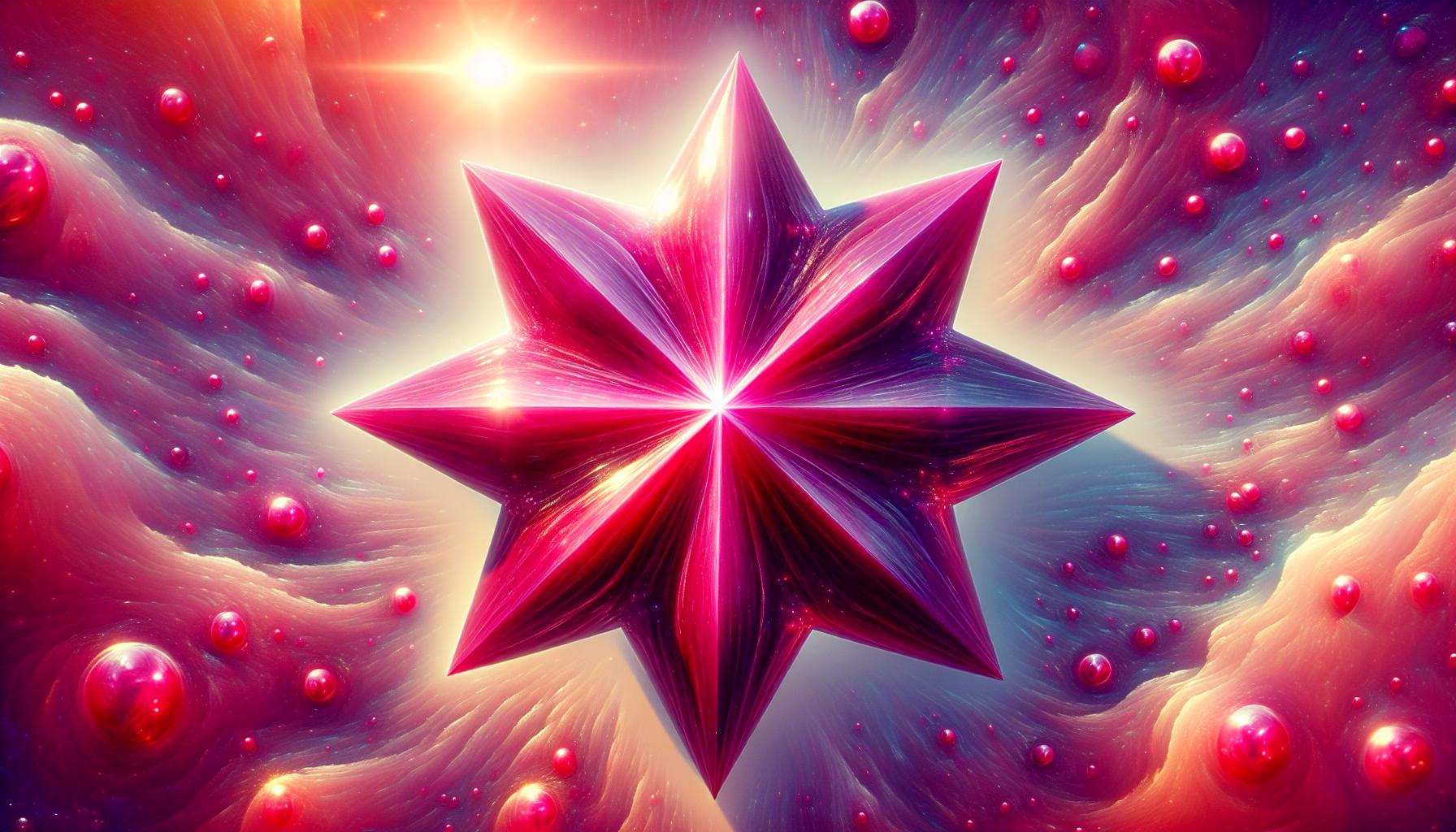
When you’re examining star rubies, you’ll notice they’re notable for their astonishing luster and asterism. This six-rayed star effect is due to aligned needle-like inclusions, typically of the mineral rutile. The star should be sharply defined, centered, and visible without any specific lighting condition. Unlike many other gemstones, the star ruby’s phenomenon is best observed under direct sunlight.
Star rubies range in color from pinkish-red to deep purplish red. The color intensity can indicate quality—the more vivid and rich, the better. Rubies with less saturation or with brown or gray hues are usually less prized. Weight, often measured in carats, plays a significant role in value too. Larger star rubies are exceedingly rare, making them more valuable with each increase in size.
While judging for imperfections, you should look for surface flaws that can detract from the stone’s beauty or for any signs that might suggest the stone has undergone treatment to enhance its appearance. Such treatments, while common, affect the rarity and value of the stone. Pay attention to symmetry as well; an off-center star, uneven color distribution, or a lopsided cut can diminish the star ruby’s enchantment.
Finally, star rubies display a distinct pleochroism, showing two different colors when viewed from different angles. This characteristic, combined with your knowledge of the gemstone’s origin and treatment history, will help you distinguish a true star ruby from imitators.
Remember, your evaluation must go beyond simple visual assessment to include detailed inspection methods like those previously discussed. Checking the specific gravity and performing a refractive index test are also essential steps to verify the gemstone’s authenticity.
How Are Star Ruby Formed?
Star rubies are a fascinating gemstone with a rich history tied to their unique formation process. These precious gems are not created overnight; they’re the product of natural forces operating over millions of years. It’s the mineral corundum, composed mainly of aluminum oxide that’s responsible for the base of a star ruby. Trace elements, particularly chromium, lead to the red color that star rubies are famous for.
Heat and pressure deep within the Earth’s crust cause corundum to crystallize gradually. Ruby formation typically occurs in metamorphic rocks, like marble, which provide the perfect conditions for their growth. Over time, these conditions can lead to the development of rutile inclusions within the ruby, creating the silky sheen and potentially leading to asterism. This phenomenon gives star rubies their unique star-like pattern.
The asterism, or star effect, appears when light is reflected off the tiny rutile fibers called “silk” in a phenomenon known as adularescence. For a well-defined star to appear, these fibers must be densely packed and aligned in three directions within the ruby. Ensuring the star is visible without external light sources is a hallmark of an authentic star ruby. With the correct cut, usually a cabochon, the light can reflect evenly across the dome, making the star effect noticeably prominent.
When inspecting potential star rubies, it’s critical to understand that not all specimens will display the coveted asterism. Only those rubies with the right conditions and inclusions will reveal the star. The formation of these exquisite gemstones is a rare and serendipitous event that combines the perfect balance of natural elements and conditions.
Preparation for Star Ruby Hunting
Before venturing out for star rubies, it’s essential to prepare thoroughly to enhance your chances of finding these gems. Here’s what you’ll need to do:
Gathering the Right Tools
Your success in hunting for star rubies heavily relies on equipping yourself with the proper tools. Here’s a list of items you’ll need:
- Loupe or Magnifying Glass: To closely examine potential star rubies for asterism and other characteristics.
- Hardness Testing Kit: Since star rubies have a significant hardness, this kit will help you distinguish real ones from imitations.
- Heavy-Duty Gloves: To protect your hands during the physical inspection of rocks.
- Geologist Hammer: For safely breaking rocks that may contain star rubies.
- UV Light: Some star rubies can fluoresce under UV light, so this can be a handy tool.
- Tweezers and a Pouch: To pick up and safely store any star rubies you may find.
Remember to bring a reliable flashlight for examining the stones in detail, especially if you’re searching in dimly lit areas or during the twilight hours.
Safety Considerations
When hunting for star rubies, your safety should be of the utmost importance. Here are some safety tips to keep in mind:
- Wear Sturdy Footwear: You’re likely to be trekking through rough terrains.
- Use Protective Eyewear: Small rock fragments can splinter off when using a hammer.
- Inform Someone of Your Location: Always let someone know where you’ll be searching for star rubies.
- Pack a First Aid Kit: Being prepared for minor injuries is essential.
- Check Weather Conditions: Don’t get caught in a storm while out in the field.
- Learn Basic Survival Skills: In case you get lost or stranded, know how to navigate and sustain yourself until help arrives.
Armed with the right tools and safety measures, you’re now set to embark on your star ruby hunting adventure. As you progress, keep in mind that patience and thoroughness are key. With every stone turned, you could be a step closer to discovering a radiant star ruby.
Handling and Care of Found Star Rubies

Once you’ve triumphed in your hunt and have a star ruby in hand, it’s crucial to maintain its condition. Proper cleaning and storage are paramount to preserving the beauty and value of your gemstone.
Cleaning and Storing Star Rubies
When it’s time to clean your newly found treasure, gentle handling is key. Star rubies require delicate care to prevent scratches or damage to their unique star pattern. Use a soft, lint-free cloth and mild soap to remove any dirt or residues. It’s vital to avoid abrasive materials or harsh chemicals which might harm the stone’s surface.
After cleaning, rinse the star ruby with lukewarm water and carefully pat it dry. If you own a gem cleaner designed for corundum-based stones, you can opt for a safe and specialized cleaning process.
Storing your star ruby is just as important as cleaning it. Wrap your gemstone in a soft cloth or place it inside a fabric-lined jewelry box. Make sure each star ruby is stored separately to avoid contact with other jewelry pieces which could cause scratches. Additionally, select a cool, dry storage location away from direct sunlight to prevent potential fading of the stone’s color.
To protect your star ruby’s asterism, consider using a gemstone case that offers both visibility and security. Should you decide to display the gem, ensure it’s in a low-traffic area where the risk of accidental knocks is minimal. Remember, star rubies are precious and often become more valuable over time, so meticulous care in cleaning and storage will safeguard your investment for years to come.
Conclusion: Confirming Real Star Ruby
Armed with the knowledge of testing methods and physical characteristics, you’re now equipped to identify a true star ruby.
Remember, thoroughness is key in confirming the authenticity of your gemstone. When you’re out in the field, safety and preparation are paramount, ensuring not just a successful hunt but also your well-being. Once you’ve found your star ruby, treat it with the care it deserves. Clean and store it properly to maintain its mesmerizing beauty for years to come.
With these insights, you’re ready to embark on your star ruby adventure, confident in your ability to uncover this rare treasure.

